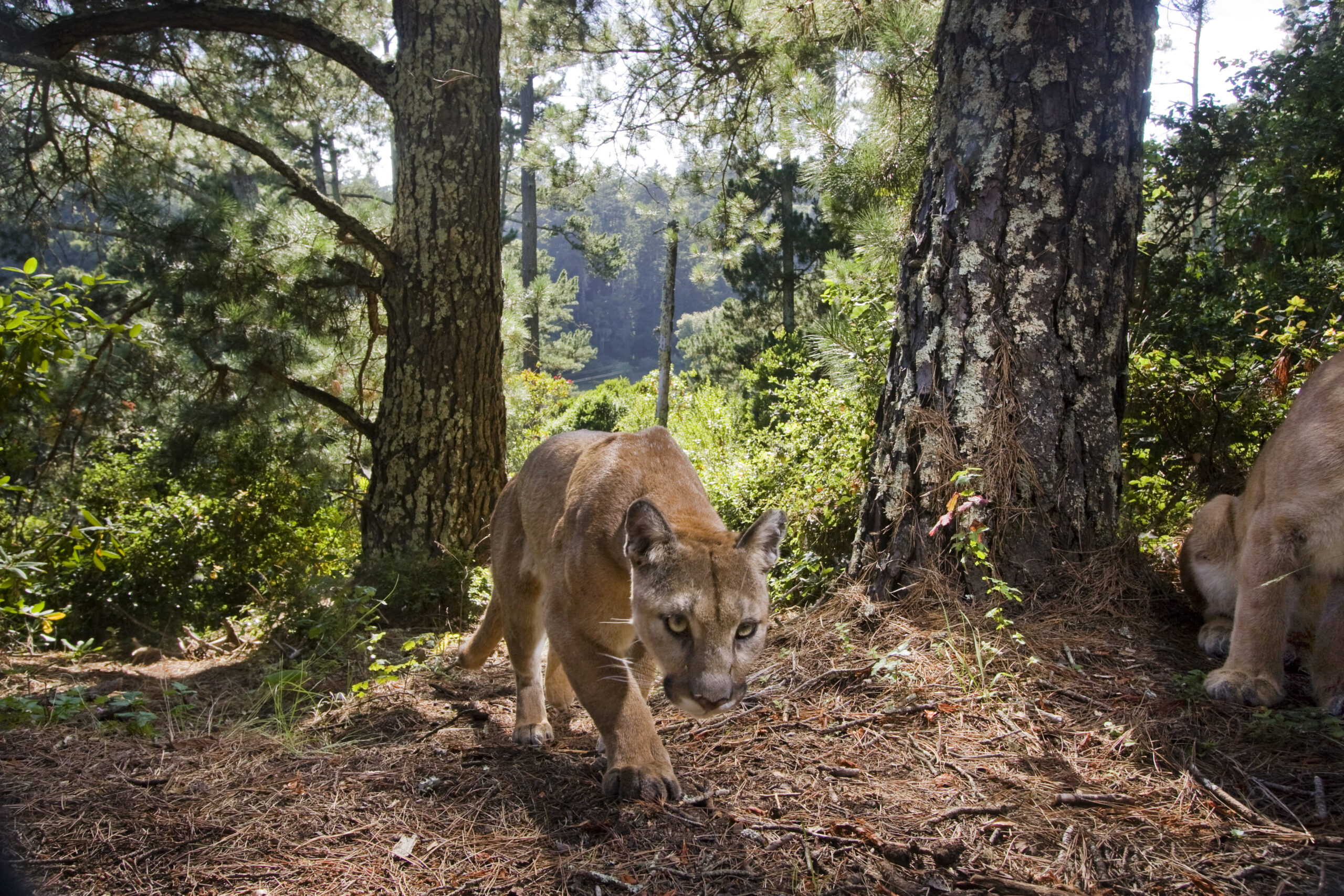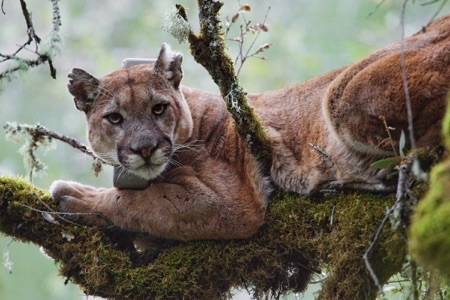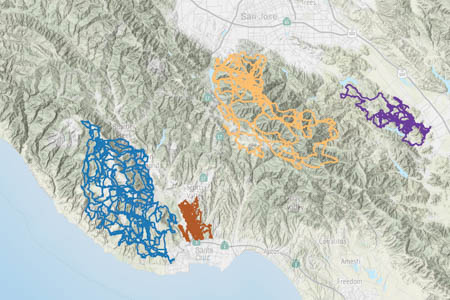Campus News
Energy spent avoiding humans linked to smaller home ranges for male pumas
New research shows that fear of humans causes mountain lions to increase their energy expenditures as they move through the landscape, and this can ultimately limit the size of the home ranges they’re able to maintain.

In the Santa Cruz mountains, pumas are top predators, patrolling a diverse landscape of forests, meadows, peaks, and valleys. But “mountain lion country” is also bordered by coastal cities to the west and Silicon Valley to the east, with major roadways and fringes of development reaching into wildlands. As a result, humans have become a major source of mortality and fear for these cats. UC Santa Cruz researchers have shown that pumas will go to great lengths to avoid human “super predators,” even bolting away from food at the sound of human voices.
And now, the research team’s latest work shows that these types of avoidance behaviors take a serious toll on pumas. A new paper, published in Proceedings of the National Academy of Sciences, shows that fear of humans causes mountain lions to increase their energy expenditures as they move through the landscape, and this can ultimately limit the size of the home ranges they’re able to maintain. Researchers are concerned about the long term impacts this might have on pumas and the ecosystems they help to regulate.
“Mountain lions fear us, and that fear has all kinds of impacts on their behavior and ecology, and ultimately, potentially even their populations and conservation,” said Professor Chris Wilmers, the senior author on the paper.
Wilmers is principal investigator for the Santa Cruz Puma Project, through which he and colleagues have been studying local mountain lion populations for over a decade. Barry Nickel, director of UC Santa Cruz’s Center for Integrated Spatial Research, led the most recent study, which relied on data from five adult female pumas and eight adult males that were outfitted with tracking collars as they roamed their natural habitats.
Calculating energy costs

mountain lions burned, which offered new insight into how physical terrain
and fear of humans affect habitat use. Photo by Sebastian Kennerknecht.
Throughout the two-month study period, the collars that researchers placed on wild pumas recorded high-resolution GPS and accelerometer data, which Wilmers said worked “essentially like a Fitbit” to help the team estimate how many calories a mountain lion burned based on where, how far, and how fast the cat was moving. The ultimate goal was to integrate the energy cost of navigating physical terrain with the cost of avoiding humans to see how both factors affect use of habitats.
To assess the impacts of physical terrain, researchers compared topography with trends in the cats’ movement data. This showed that less rugged terrain requires less energy for pumas to navigate, which may help to explain why mountain lions prefer habitats with easy-to-traverse valleys or ridges. And to get a sense for how fear of humans affected the cats, researchers also compared housing densities with collar tracking data.
This analysis showed that, in areas with higher housing densities, pumas were engaging in more energetically demanding movements, like stopping less and moving more quickly. Their movements were also much less efficient: instead of taking the shortest path to their destination, they took longer, meandering paths to navigate around perceived risks.
“Humans, as a risk factor, are actually increasing the energy an animal needs to traverse this landscape,” Nickel explained. “And this is primarily through changes in their behavior as a means to avoid humans.”
Fear takes a serious toll

home range area covered by pumas in habitats with the highest housing
density (purple and brown tracks) compared with those in wildlands
(yellow and blue tracks).
The constant vigilance cats used as they moved through human-dominated landscapes is incredibly energy intensive. Nickel and the research team estimate that, in otherwise identical terrain, pumas expend 13 percent more calories per five-minute period in habitats close to people than they would in remote wildland habitats.
As a result, researchers found that fear of humans had a greater impact than variations in terrain on the amount of energy it takes for mountain lions to move about their habitats. In fact, the effect of increasing housing density on energetic costs of movement was four to 10 times greater than the effect of increasing slope and ruggedness of the terrain.
That’s a problem because researchers haven’t observed a corresponding increase in calorie consumption from the cats, and the other most likely way pumas might compensate for increased energy costs in navigating their habitats would be to reduce the total size of their territories. This trend showed up very clearly in the tracking data.
Both males and females showed reduced size in their home ranges associated with overall increased energy costs of navigating the landscape, but males, in particular, were especially affected by housing density. Male pumas in habitats most dominated by humans had 78.8 percent smaller home ranges compared to those with the most remote habitats.
Human-induced risk has actually become the primary driver of male patterns of space use among pumas, according to the paper. Females didn’t show this same trend, but the research team suspects males may be more vulnerable to human impacts because they typically have to establish larger home ranges to improve their odds of finding a mate.
Conservation implications

reaches into natural areas around the Santa Cruz mountains. Photo by
Sebastian Kennerknecht.
Overall, researchers are concerned that pressure to avoid humans may harm the health of local mountain lion populations.
“It constrains their space use, which could then affect other aspects of their ecology, like finding mates, finding food, competing with other males, or other natural interactions,” Nickel said.
Because these cats are apex predators that help to control populations of prey—like deer and racoons—any impacts to puma populations have the potential to cascade out and affect other species. That makes mountain lions a key factor in the long term health of ecosystems across the Santa Cruz mountains.
The research team hopes this will motivate consideration of ways to reduce human impacts. Wilmers says one of the best strategies for helping pumas is to limit the amount of development that reaches into natural areas, so that these cats can have safe places to roam without fear.
“If we continue to develop California in the way we historically have, we’re going to lose this species,” Wilmers said. “But if we focus our development on making housing more dense in the areas where it already exists, like cities, then we stand a chance of keeping mountain lions with us well into the future.”